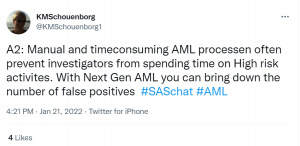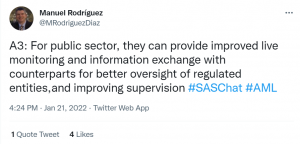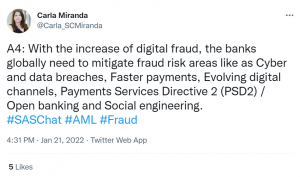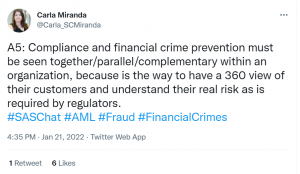The fight against fraud and money laundering is an ongoing one. Fraudsters move fast to stay ahead of their targets, and it is hard for organizations to keep on top of the situation. New regulations have recently targeted anti-money laundering as a way to prevent terrorist financing and tax avoidance – and analytics can help to boost capabilities in this area. Our expert panel recently discussed this issue (the full discussion is here). These are my top takeaways.
Banks are important, but money laundering is not just about financial institutions
Banks and financial institutions are crucial in anti-money laundering. However, criminals are becoming ever more inventive as they seek to circumvent regulations designed to catch money laundering. A recent blog post by Adrian Niga gave examples of luxury cars and double-glazing contracts. But there are many more, including buying cryptocurrencies and other digital currencies.
Analytics is crucial in reducing the cost of AML
One of the challenges with anti-money laundering practices is that they can be expensive. Traditional fraud detection needed large teams of people to crawl through transactions. And even then, they usually only found problems after the event, and often after significant losses. Analytics reduces the cost of anti-money laundering work through automation. It also reduces losses and avoids the cost of recovery by detecting patterns and potential fraud before the event.
Analytics can improve both efficiency and effectiveness of detection
Anti-money laundering practices need to be both efficient and effective. They must review large numbers of potential cases of fraud or anti-money laundering quickly, and must also be able to identify the problem cases. Analytics supports both of those aims. It means that organizations can process large amounts of data very fast, and allows investigators to focus on the most likely cases.
The potential for real-time monitoring is particularly important in risk management
Real-time monitoring to detect anti-money laundering has several benefits. The most obvious is the potential to detect fraud before any money has been lost. However, it is also important for faster risk assessment and management. Organizations may also find it useful for managing onboarding processes, as well as improving governance and auditability.
Real-time monitoring also has some risks
The big advantage of real-time monitoring is being able to track money and stop the flow before it can benefit criminals. But this also has risks for genuine customers. You must be confident that your false-positive rate is low to avoid inconveniencing or even criminalizing the good guys. Customers may be prepared to accept some delays to improve their security – but not a criminal record. Fortunately, next-generation AML analytics can help to reduce the false-positive rate.
We must also improve data- and intelligence-sharing
Analytics in fraud or anti-money laundering detection can only take you so far. Public sector authorities, in particular, need to go beyond simple monitoring or detection to information and intelligence sharing. Criminal networks are not bound by the borders of public institutions, or even nation-states. So fraud detection needs to be similarly international.
Still many areas of fraud that are hard to detect
The COVID-19 pandemic has hugely increased the number of digital financial transactions – and thus the potential for fraud. This shift in behavior is exacerbated by the growth of digital currencies, providing even more opportunities for crime. Banks and financial institutions have more and more areas to cover, including faster payments, data security (and breaches) and open banking. On top of all this, cash-based money laundering is still difficult to detect and address.
Compliance and financial crime prevention must be seen as complementary
It should not be a matter of "balancing" regulatory compliance and financial crime prevention. Instead, the two go hand in hand. Regulatory compliance only highlights the best way to prevent financial crime by getting a full picture of each customer. Prevention is in fact part of compliance and vice versa.
Don't lose sight of the main goal when considering responsibility
There are many different levels of responsibility for anti-money laundering. Regulations are often open to interpretation – and organizations and regulators may take very different views. However, it is important that neither regulators nor financial organizations lose sight of the fact that the main goal is NOT who takes responsibility – but detecting and reducing money laundering and fraud.
To better understand if Romania needs to boost its anti-money laundering capabilities, SAS and UBB FSEGA have partnered to explore the readiness of the market to address modern money laundering challenges. To find out more, visit Real-Time Anti-Money Laundering in Romania.











